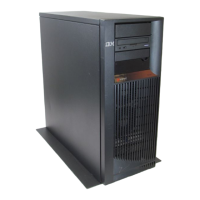Example: Communications subsystem configuration
1. Create a duplicate of QCMN:
CRTDUPOBJ OBJ(QCMN) FROMLIB(QSYS) OBJTYPE(*SBSD) TOLIB(MYLIB) NEWOBJ(MYCMN)
2. Set up the communication entries:
ADDCMNE SBSD(MYLIB/MYCMN) DEV(PC*)
ADDCMNE SBSD(MYLIB/MYCMN) DEV(PC*) MODE(QSERVER) MAXACT(0)
ADDCMNE SBSD(QSYS/QCMN) DEV(PC*) MODE(QPCSUPP) MAXACT(0)
3. If desired, update your system startup program to start your new subsystems automatically.
Communications performance considerations for interactive jobs
An interactive job is one that uses a keyboard and character-type display. If a job needs the user to type
on the keyboard and display character results, that job is probably considered interactive. Interactive in this
sense means that the job and the user depend on each other to get the work done.
To optimize communications performance for interactive jobs, consider the following:
v Attach work stations through communications requires more CPU overhead than 5250 local
workstations.
v Use a twinaxial controller to provide better performance than an American National Standard Code for
Information Interchange (ASCII) controller.
v Keep the line utilization below 30 percent for best performance when interactive users are attached.
This will maintain predictable and consistent response times. Exceeding 50 to 60 percent line utilization
will usually cause unacceptable response times.
If your system has interactive users who are connected many different ways, you should consider
configuring your interactive subsystems to separate the users. Local workstation, remote workstations,
5250 display station pass-through, or Telnet are some examples of these types of connections that should
be separated. When you configure interactive subsystems, identify how you want the interactive users to
be separated and create the appropriate subsystem descriptions.
During error recovery, when many users risk losing their sessions at one time, an interactive subsystem
can be very busy performing device recovery. This device recovery can adversely affect the work of other
users in the subsystem who would otherwise be unaffected by the failure. Therefore, you may need to
change how the interactive subsystems are configured. However, multiple subsystems can provide multiple
processes to do cleanup and recovery when error conditions occur. This can result in improved
performance.
The example below shows how to configure an interactive subsystem to allocate devices that begin with
devname* and present a signon display on those display devices:
ADDWSE SBSD(libname/sbsname) WRKSTNDEV(devname*) AT(SIGNON)
Use the following example to configure an interactive subsystem so that the device name devname* is not
allocated and a signon display does not appear.
ADDWSE SBSD(libname/sbsname) WRKSTNDEV(devname*) AT(*ENTER)
Adding workstation entries with AT(*ENTER) allows you to use the Transfer Job (TFRJOB) function into
that subsystem. If the TFRJOB function is not required or necessary, there is no need to add the
workstation entries with AT(*ENTER).
To specify the devices an interactive subsystem should allocate when the subsystem is started:
ADDWSE SBSD(libname/sbsname) WRKSTN(devname*) AT(*SIGNON)
To specify the devices an interactive subsystem should not allocate when the subsystem is started:
ADDWSE SBSD(libname/sbsname) WRKSTN(devname*) AT(*ENTER)
v See the following example for a way of configuring your interactive subsystem.
12 Version 5

